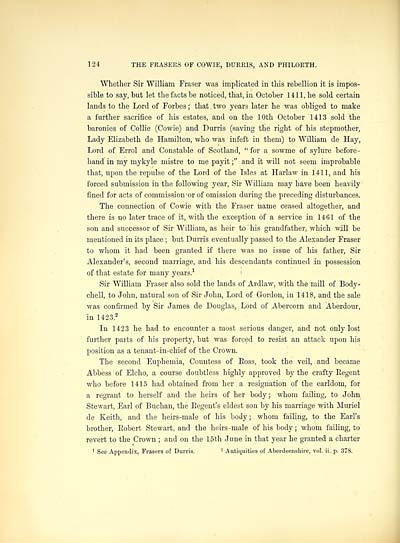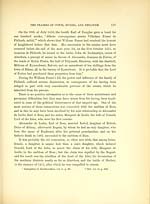Frasers of Philorth > Volume 1
(158)
Download files
Complete book:
Individual page:
Thumbnail gallery: Grid view | List view

124 THE FRASERS OF COWIE, DURRIS, AND PHILORTH.
Whether Sir William Eraser was implicated in this rebellion it is impos-
sible to say, but let the facts be noticed, that, in October 1411, he sold certain
lands to the Lord of Forbes ; that two years later he was obliged to make
a further sacrifice of his estates, and on the 10th October 1413 sold the
baronies of Collie (Cowie) and Durris (saving the right of his stepmother,
Lady Elizabeth de Hamilton, who was infeft in them) to William de Hay,
Lord of Errol and Constable of Scotland, " for a sowme of sylure before-
hand in my mykyle mistre to me payit ;" and it will not seem improbable
that, upon the repulse of the Lord of the Isles at Harlaw in 1411, and his
forced submission in the following year, Sir William may have been heavily
fined for acts of commission - or of omission during the preceding disturbances.
The connection of Cowie with the Eraser name ceased altogether, and
there is no later trace of it, with the exception of a service in 1461 of the
son and successor of Sir William, as heir to his grandfather, which will be
mentioned in its place ; but Durris eventually passed to the Alexander Eraser
to whom it had been granted if there was no issue of his father, Sir
Alexander's, second marriage, and his descendants continued in possession
of that estate for many years. 1
Sir William Fraser also sold the lands of Ardlaw, with the mill of Body-
chell, to John, natural son of Sir John, Lord of Gordon, in 1418, and the sale
was confirmed by Sir James de Douglas, Lord of Abercorn and Aberdour,
in 1423. 2
In 1423 he had to encounter a most serious danger, and not only lost
further parts of his property, but was forced to resist an attack upon his
position as a tenant-in-chief of the Crown.
The second Euphemia, Countess of Eoss, took the veil, and became
Abbess of Elcho, a course doubtless highly approved by the crafty Eegent
who before 1415 had obtained from her a resignation of the earldom, for
a regrant to herself and the heirs of her body; whom failing, to John
Stewart, Earl of Buchan, the Eegent's eldest son by his marriage with Muriel
de Keith, and the heirs-male of his body; whom failing, to the Earl's
brother, Eobert Stewart, and the heirs-male of his body ; whom failing, to
revert to the Crown ; and on the 15th June in that year he granted a charter
1 See Appendix, Frasers of Durris. 2 Antiquities of Aberdeenshire, vol. ii. p. 378.
Whether Sir William Eraser was implicated in this rebellion it is impos-
sible to say, but let the facts be noticed, that, in October 1411, he sold certain
lands to the Lord of Forbes ; that two years later he was obliged to make
a further sacrifice of his estates, and on the 10th October 1413 sold the
baronies of Collie (Cowie) and Durris (saving the right of his stepmother,
Lady Elizabeth de Hamilton, who was infeft in them) to William de Hay,
Lord of Errol and Constable of Scotland, " for a sowme of sylure before-
hand in my mykyle mistre to me payit ;" and it will not seem improbable
that, upon the repulse of the Lord of the Isles at Harlaw in 1411, and his
forced submission in the following year, Sir William may have been heavily
fined for acts of commission - or of omission during the preceding disturbances.
The connection of Cowie with the Eraser name ceased altogether, and
there is no later trace of it, with the exception of a service in 1461 of the
son and successor of Sir William, as heir to his grandfather, which will be
mentioned in its place ; but Durris eventually passed to the Alexander Eraser
to whom it had been granted if there was no issue of his father, Sir
Alexander's, second marriage, and his descendants continued in possession
of that estate for many years. 1
Sir William Fraser also sold the lands of Ardlaw, with the mill of Body-
chell, to John, natural son of Sir John, Lord of Gordon, in 1418, and the sale
was confirmed by Sir James de Douglas, Lord of Abercorn and Aberdour,
in 1423. 2
In 1423 he had to encounter a most serious danger, and not only lost
further parts of his property, but was forced to resist an attack upon his
position as a tenant-in-chief of the Crown.
The second Euphemia, Countess of Eoss, took the veil, and became
Abbess of Elcho, a course doubtless highly approved by the crafty Eegent
who before 1415 had obtained from her a resignation of the earldom, for
a regrant to herself and the heirs of her body; whom failing, to John
Stewart, Earl of Buchan, the Eegent's eldest son by his marriage with Muriel
de Keith, and the heirs-male of his body; whom failing, to the Earl's
brother, Eobert Stewart, and the heirs-male of his body ; whom failing, to
revert to the Crown ; and on the 15th June in that year he granted a charter
1 See Appendix, Frasers of Durris. 2 Antiquities of Aberdeenshire, vol. ii. p. 378.
Set display mode to:
![]() Universal Viewer |
Universal Viewer | ![]() Mirador |
Large image | Transcription
Mirador |
Large image | Transcription
Images and transcriptions on this page, including medium image downloads, may be used under the Creative Commons Attribution 4.0 International Licence unless otherwise stated. ![]()
| Histories of Scottish families > Frasers of Philorth > Volume 1 > (158) |
|---|
| Permanent URL | https://digital.nls.uk/96567396 |
|---|
| Attribution and copyright: |
|
|---|
| Description | A selection of almost 400 printed items relating to the history of Scottish families, mostly dating from the 19th and early 20th centuries. Includes memoirs, genealogies and clan histories, with a few produced by emigrant families. The earliest family history goes back to AD 916. |
|---|

